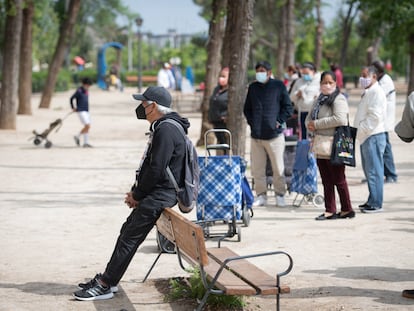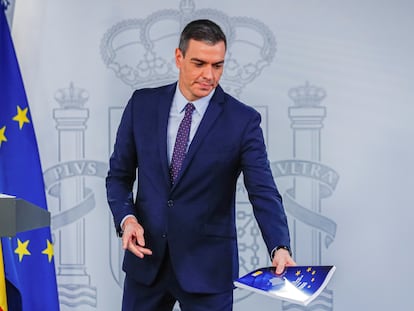Spain receives €9 billion in first tranche of EU recovery funds
According to the Economy Ministry, the country will receive another €10 billion in December, and will be sent 80% of the planned transfers between 2021 and 2022
The European Commission announced on Tuesday that it has already sent €9 billion of prefinancing to Spain – that’s 13% of the €69.5 billion of transfers that the government’s “Recovery and Resilience Facility (RRF)” is due to receive in the wake of the coronavirus pandemic. The money must be spent on investments and reforms that underpin the green and digital transitions and that also promote social cohesion.
Among these initiatives, Brussels cited in its press release support for renewable energies, the refurbishment of buildings to make them more energy efficient, the improvement of digital skills among citizens and the reduction of youth unemployment via professional training programs.
The president of the European Commission, Ursula von der Leyen, said in the statement: “I am convinced that Spain’s ambitious plan will provide a crucial push for the European Green Deal to become a reality, it will further digitalize the economy and it will make Spain more resilient than ever.”
Today's disbursement of #NextGenerationEU funds launches the implementation of Spain's recovery and resilience plan.
— Ursula von der Leyen (@vonderleyen) August 17, 2021
The ambitious plan will provide a crucial push to make the #EUGreenDeal a reality, further digitalise the economy & make 🇪🇸 more resilient than ever. pic.twitter.com/PudeCm5kxS
Meanwhile, via Twitter, Spanish Prime Minister Pedro Sánchez said: “We continue to move toward a country that is more green, digital, feminist and cohesive, putting into operation the major transformations that our economy needs.”
La Comisión Europea ha entregado ya a España los primeros 9.000 millones para la prefinanciación del #PlanDeRecuperación. Seguimos avanzando hacia un país más verde, digital, feminista y cohesionado, poniendo en marcha las grandes transformaciones que nuestra economía necesita. https://t.co/OnLLkik2sL
— Pedro Sánchez (@sanchezcastejon) August 17, 2021
The funds were released in the middle of July, when the European Union’s finance ministers gave the definitive green light to the recovery plan under which Spain is hoping to access up to €140 billion, a total that includes loans that Spain is yet to request – it has until 2026 to do so. The following transfers, however, will not be automatic. Spain will have to demonstrate to the EC and its partners every six months that it has carried out the reforms and investments that it has committed to if it wants to access the funds.
The arrival of the money brings to an end months of uncertainty due to delays and complications for the definitive ratification of the funds, and this will not be the only check sent from Brussels to Madrid. According to the Economy Ministry, Spain will receive another €10 billion this year, in December, and will also be sent 80% of the planned transfers between 2021 and 2023. These huge sums will also be accompanied by a further €38 billion of European structural funds.
Given the urgent task of distributing these funds in order to boost recovery, the Spanish government has taken steps to ensure that the money flows rapidly. The country’s regions have already been assigned more than €7.25 billion, which, according to the Economy Ministry, will be used primarily to support the implementation of waste-management regulations, work on power lines to avoid damage to wildlife, the refurbishment of buildings, improvements to water-treatment services, modernizing vocational training, reducing the digital divide, boosting equality and social inclusion policies, and improving health technologies.
Spain has so far received more than 17,500 proposals and has approved a strategic project for electric vehicles
Until now, the Spanish government has published 25 expressions of interest related to the plan. It has received more than 17,500 proposals and has approved a strategic project for electric vehicles, under which it is hoping to mobilize €24 billion in three years thanks to public-private partnerships.
Brussels intends to raise up to €80 billion in long-term funding this year, “to be complemented by short-term EU-Bills, to fund the first planned disbursements to Member States under NextGenerationEU,” the latter a reference to the global EU recovery package to support member states hit by the Covid-19 pandemic.
The funds will allow Brussels to finance an agenda of investments and reforms that will be rolled out across the EU with particular intensity over the next three years in order to strengthen the 27 member states after the crisis caused by the pandemic.
“The way out of this crisis is already being very different from that of the previous financial crisis,” said Spain’s economy minister and deputy prime minister, Nadia Calviño, during a video message recorded to coincide with the arrival of the first tranche of European funds.
While the payment was expected, it has great symbolism given that this is the first time that the bloc has taken on debt in order to support its member states. Italy, which received an advance payment of €24.9 billion on Friday, and Spain will be the countries that benefit most from the recovery plan. The first countries to receive European funds, at the beginning of this month, were Portugal (€2.2 billion), Belgium (€770 million) and Luxembourg (€12.1 million). Several days later, Greece received €4 billion.
With the injection of funds from the recovery plan, the government and companies are facing a massive challenge, given that they will have to be able to put thousands of projects into motion in order to avoid part of the money going unused, as has happened in the past with other European funds.
The government is planning for the funds to be used, among other initiatives, to digitalize more than a million small- and medium-sized businesses, supporting more than 3,000 companies as they become more international, training more than 2.6 million people in digital skills, installing more than 240,000 interactive digital classrooms, refurbishing more than a million homes, reaching a fleet of at least 250,000 electric vehicles in 2023 with more than 100,000 charging points, modernizing the justice system so that at least 30% of judicial procedures take place online, rolling out high-speed internet to 100% of the population, and building more than 335 kilometers of rail track on the Atlantic and Mediterranean coasts.
English version by Simon Hunter.
Tu suscripción se está usando en otro dispositivo
¿Quieres añadir otro usuario a tu suscripción?
Si continúas leyendo en este dispositivo, no se podrá leer en el otro.
FlechaTu suscripción se está usando en otro dispositivo y solo puedes acceder a EL PAÍS desde un dispositivo a la vez.
Si quieres compartir tu cuenta, cambia tu suscripción a la modalidad Premium, así podrás añadir otro usuario. Cada uno accederá con su propia cuenta de email, lo que os permitirá personalizar vuestra experiencia en EL PAÍS.
¿Tienes una suscripción de empresa? Accede aquí para contratar más cuentas.
En el caso de no saber quién está usando tu cuenta, te recomendamos cambiar tu contraseña aquí.
Si decides continuar compartiendo tu cuenta, este mensaje se mostrará en tu dispositivo y en el de la otra persona que está usando tu cuenta de forma indefinida, afectando a tu experiencia de lectura. Puedes consultar aquí los términos y condiciones de la suscripción digital.
More information
Últimas noticias
Most viewed
- Sinaloa Cartel war is taking its toll on Los Chapitos
- Oona Chaplin: ‘I told James Cameron that I was living in a treehouse and starting a permaculture project with a friend’
- Reinhard Genzel, Nobel laureate in physics: ‘One-minute videos will never give you the truth’
- Why the price of coffee has skyrocketed: from Brazilian plantations to specialty coffee houses
- Silver prices are going crazy: This is what’s fueling the rally











































